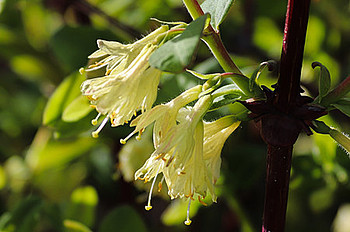Many names: honeyberry, mayberry or blue honeysuckle
The home of the berry with the many names is eastern Russia. Besides Siberia, it is found mainly on the Kamchatka peninsula and the Kuril Islands. It likes it damp and prefers high moors, rivers, damp forests and swamps. The Haskap berry is not only frost-resistant, but also quite adaptable: In the mountains, it can withstand altitudes of up to 2,000 metres. In the meantime, the Haskap berry is also cultivated in Japan, China and Canada, and on a smaller scale in Poland and Great Britain. Although the economic importance of the Haskap berry in Europe is still low, more and more producers are taking a liking to the robust little fruit.
How the haskap berry grows

The botanical name of the mayberry is Lonicera caerulea. The plant is a deciduous shrub from the honeysuckle family that reaches a height of up to two metres. As soon as the spring sun unfolds its power, the first buds appear on the shoots of the previous year. The flowers of the honeyberry have a yellow-white colour and are very popular with bumblebees and bees. The Haskap berry bears fruit as early as May. This is earlier than with most berry species. Externally, they are distantly reminiscent of wild blueberries, but Haskap berries, unlike the other varieties, have an elongated shape and grow to about two to five centimetres long.
Ingredients of the Siberian blueberry
Similar to the native blueberry, the Siberian blueberry (Haskap berry) also has a strong, deep blue colour: the anthocyanins from the flavonoid group are responsible for this. The natural manganese content of the Haskap berries is particularly noteworthy. This is because manganese can help protect the cells of our body from oxidative stress.
Taste and processing
The Haskap berry is a great way to start the berry season early, and its flavour is a mixture of various other berry varieties. The tart-sweet aroma is reminiscent of blueberries as well as raspberries and blackberries. The juicy fruits can be eaten raw without any problems and also taste great in fruit salads. A few more ideas on how you can use Haskap berries:
- In cakes and pastries
- In cocktails and drinks
- For a jam or marmalade
- Processed as a compote
Haskap berries are also popular for making fruit powder, jam, juice or syrup. At Rabenhorst, we produce our Haskap Berry juice from carefully selected fruits that are only pressed once and processed into a pure juice (pure juice from first pressing). In our article "What is pure juice from first pressing?" you can learn more about our gentle processing method.
FAQ
Are haskap berry, mayberry and honeyberry the same thing?
Yes, all names mean the same fruit. The Haskap berry is also known as Siberian blueberry, blue honeysuckle or Kamchatka honeysuckle.
Where does the haskap berry grow?
The haskap berry originates from Siberia and grows mainly in cooler northern climates. It is cultivated in Japan, China and Canada and is also becoming increasingly popular in Europe.
Can you eat haskap berries raw?
Yes, haskap berries are well suited for raw consumption. However, if you prefer to enjoy the Haskap berry in processed form, our Haskap berry juice from Rabenhorst is a good choice, for example.

